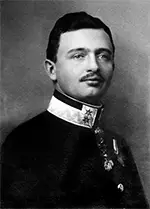KarI: Emperor of Austria-Hungary
Karl I was the last emperor of Austria-Hungary. He reigned for nearly two years, in the waning days of World War I. He was born on Aug. 17, 1887, in Persenbeug Castle, in Persenbeug-Gottsdorf, Lower Austria. His father was Archduke Otto Franz of Austria, and his mother was Princess Maria Josepha of Saxony. The Emperor of Austria at the time was Franz Josef, the baby's grand-uncle. 
Karl grew up a bit of a nomad, moving around as his father's army regiment did. The boy had private tutors for a time, and then he followed his father into the army, studying law and political science in his spare time. He also studied science at a famous school in Vienna. On Oct. 21, 1911, Karl married Princess Zita of Bourbon-Parma. They had eight children, all of whom survived into adulthood: Otto (1912), Adelheld (1914), Robert (1915), Felix (1916), Karl Ludwig (1918), Rudolf (1919), Charlotte (1921), and Elisabeth (1922). Karl's father had died in 1906. After that, the heir to the throne was Archduke Franz Ferdinand, Karl's uncle, and Karl himself was second in line. After the assassination of the archduke in 1914, Karl was next in line for the pinnacle of power, behind his uncle Franz Josef. Karl became emperor on Nov. 21, 1916, when Franz Josef died. By that time, the war was going badly for Austria-Hungary. Not long into his reign, Karl began secret negotiations with France to bring about peace between those two entities, going so far as to employ his brother-in-law, an officer in the Belgian Army, as a go-between. That envoy, Prince Sixtus of Bourbon-Parma, was unable to convince France to accept a peace that did not include territorial concessions to Italy, which had begun the war as a neutral nation but had joined the Allied side in 1915. Karl, as archduke and as emperor, tried other avenues, promising Alsace-Lorraine to France and even offering Austrian Silesia in exchange for a peace agreement; none of these overtures succeeded. A further frustration came courtesy of the Austrian foreign minister, Graf Czernin, who insisted on a peace agreement that included Germany. News of the secret negotiations reached many ears, and Czernin resigned; further, a disgusted Germany insisted on taking control of Austria-Hungary's war machine. The Austro-Hungarian Empire had existed as a collection of native peoples; tensions among those groups reached a fever pitch the more the war went against their army, and Karl in late 1918 agreed to create a confederation that oversaw the native peoples' running their own territories. As famine became widespread, he founded the Ministry of Public Health and the Ministry of Social Welfare, setting up avenues for the distribution of food and aid to the people behind the lines. Even that was not enough, as the newly emboldened native peoples spoke out for full autonomy. With little choice, Karl agreed to a splintering of the empire, granting Poland full independence and shaping the rest of the empire into a four-part federal union, each governed by a federal council. The disastrous results of the Austro-Hungarian army, however, resulted in the emperor's having little credibility left as a leader. As the war wound down, more and more of the empire split into self-declared independent states. Karl took the drastic step of declaring a new constitution, but the momentum was against him. The final wound was the end of the personal union between Austria and Hungary, which came on October 31, 1918. 
When the war officially ended, 11 days later, Karl and his family left the imperial palace. He had issued a proclamation giving his assurance that the Austrian people could form whatever government they wished, carefully avoiding the use of the word "abdicate," in case the people decided that they wanted him to rule again. That was not at all the case. The Republic of German-Austria came into existence on November 12, and the First Hungarian Republic followed four days after that. Karl and his family were still in residence east of Vienna, but he was no longer the emperor and the former empire was getting along just fine as independent entities without him. Karl and his family went to Switzerland in March 1919, with the former emperor reasserting his right to rule even as he left. The Austrian Parliament on April 3 passed the Habsburg Law, which officially cut all ties with the Habsburg line and prohibited Karl specifically from ever returning. He still had friends in high places and tried twice in 1921 to reclaim the Hungarian throne; he was thwarted both times by the regent, Hungary's last military commander, Admiral Miklos Horthy. The second time, fighting ensued and soldiers died, but Karl, seeing his chances slip away, surrendered. Hungary in that year followed Austria's lead, declaring null and void the Pragmatic Sanction, which been established imperial policy since its inception centuries earlier. Karl's second coup attempt ended in his arrest. He and his wife, Zita, were detained and then exiled, to the Portuguese island Madeira. Their children joined them there. Karl suffered illness and then, on April 1, 1922, died. He was 34. |
|
Social Studies for Kids
copyright 2002–2024
David White




